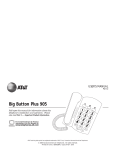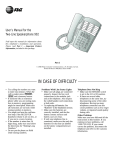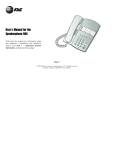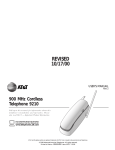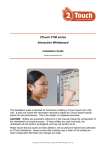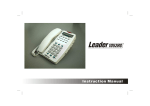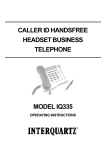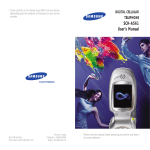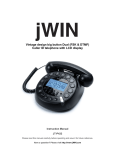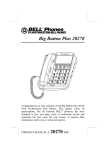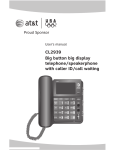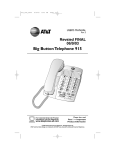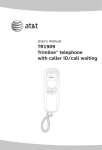Download AT&T 925 User's Manual
Transcript
User's Manual for the Speakerphone 925 THIS NUM BER PRO LOW GRA M ER PAU S E FLA SH MU TE 1 HO LD AB 4 Fold open this manual for information about this telephone’s installation and operation. Please read Part 1 — Important Product Information, included in this package. 2 GH 5 PQ 7 C DE I RS 8 TO NE RE DIA MN 6 TU V O VO LU WX 9 OP 0 3 JKL F YZ ER # SPE AKE Part 2 © 1998 Philips Consumer Communications, L.P. All rights reserved. Printed in Mexico. 848236055 Issue 1AT&T R ME L INSTALLATION NOTE: This telephone requires a modular telephone jack. Table If you have a wall-mounted telephone, remove the telephone from the wall and follow these instructions: 1 Remove the base. 2 Connect line cord to telephone. Plug the seven-foot line cord into the LINE jack on the bottom of the telephone. 3 Attach the base. Turn the base so that the larger end of the base is toward the top of the telephone. Attach the base by inserting the tabs into the slots. Push down on the large end of the base to lock it into place. 4 Connect the line cord to your modular jack. Plug the free end of the line cord into a modular jack. Make sure it snaps firmly into place. 5 Connect handset to telephone. Plug the coiled cord into the handset jack on the side of the phone. Plug the other end of the coiled cord into the handset, and then hang up. 6 Check for dial tone. Lift the handset and listen for a dial tone. If you cannot hear a dial tone, turn to “In Case of Difficulty.” Wall 1 Remove the base. 2 Connect the line cord to telephone. Do not unbundle line cord. Plug the seven-foot line cord into the LINE jack on the underside of the phone. Leave enough cord free to connect to the wall jack, but keep any excess cord unbundled. Store the bundled cord in the open area under the set. 3 Attach the base. Turn the base so that the larger end of the base is toward the bottom of the telephone. Attach the base by inserting the tabs into the slots. Push down on the large end of the base to lock it into place. 4 Reverse handset tab. To mount the telephone on a wall, you must reverse the handset tab. This tab holds the handset when you hang up. Hold down the switchhook, and slide the tab up and out of its slot (Figure 1A). Turn the tab so that the curved end is up (Figure 1B). Then insert the tab back into its slot (Figure 1C). Figure 1A Figure 1B 1 5 Connect the line cord to modular wall jack and mount phone onto wall jack. Make sure the cord snaps firmly into place. Place the phone on the wall jack mounting studs and pull down until it is held securely. Follow Steps 5 and 6 under “Table” Installation. Dial Mode Selection This telephone will work with tone or dial pulse (rotary) service. Even when set to dial pulse service, the phone can be switched temporarily to tone, for access to services that require tone signaling, including some toneactivated computer systems. This product comes set in the touch-tone mode. Make sure you choose the correct dialing method; touch-tone dialing will not work if you have dial pulse service. After the telephone is plugged in, if you have dial pulse (rotary) service, lift handset and press , , , , . To change back to touch tone service, lift the handset, then press , , , , . Hang the handset up for dial mode selection to take effect. To switch from pulse to tone dialing during a phone call, see “Temporary Tone Dialing.” Figure 1C TELEPHONE OPERATION Switchhook (under handset) Handset Accesses memory dialing numbers Directory Card/Cover Access Call Waiting or other services One-Touch Memory Locations Programs a pause in memory Two-Touch Memory Locations Programs a number in memory THIS NUM BER PRO GRA M LOW ER PAU SE FLA Ringer Volume SH MU 1 TE HO LD AB C 4 2 GH I 5 PQ RS JKL TO NE F RE DIA L MN O 7 8 Accesses two-touch memory dialing numbers DE 3 6 TU V VO LU WX YZ ME 9 OP ER Puts a call on hold 0 # SPE Mutes a call AKE R Redials last call made Speaker/Handset Volume Temporary Tone Turns speaker on and makes a call 2 TELEPHONE OPERATION continued Making and Answering a CallÑHandset Lift the handset to make and receive calls as you usually would. Making and Answering a CallÑ Speakerphone NOTE: The red speakerphone light will go on when the speakerphone is being used. To make a call using the speakerphone, press and hold until the speakerphone light comes on, wait for dial tone, then dial (either manually or using the memory feature). To answer a call using the speakerphone, press and hold until the speakerphone light comes on (do not lift handset). When the call is finished, press again to hang up. To switch from handset to speakerphone, press . To switch from speakerphone to handset, lift the handset. NOTE: Using an extension phone is not recommended while using the speakerphone. Volume Button The VOLUME button adjusts the speaker or the handset during your call. Adjusting one does not affect the other. When on a call, press to increase volume, to decrease volume. Redial The telephone stores in memory the last number you called. The number (up to 24 digits) will remain in the Redial memory until you dial another number. To dial the same number again, lift the handset or press , listen for the dial tone, and press . To erase Redial, lift the handset or press , press , , then again. Hold The Hold feature allows you to keep a call on the line while you step away from the phone or while someone takes the call on an extension phone. When a call is on Hold, the red HOLD light flashes, and nothing either party says can be heard. You cannot access any special features. To activate, press and release , and place the handset back in the cradle. When using the speakerphone, press and release . To release Hold, lift the handset from the cradle or press — OR — Lift the handset of an extension phone of the line on Hold — OR — If the handset is not in the cradle, press or lift the handset and press . Mute The Mute feature allows you to hear your caller, but your caller will not be able to hear anything you say. Press and release (the red MUTE light goes on) to talk privately with someone else in the room without the person on the phone hearing you. Press and release again (the MUTE light goes off) to continue your conversation with the other party. Flash The Flash feature is useful if you have subscribed to custom calling services from your local telephone company. Press instead of the switchhook to activate services such as call waiting or three-way calling. You may have to press other buttons before or after as explained in the custom calling instructions provided by your local telephone company. The button is used only as a substitute for pressing the switchhook. 3 Temporary Tone Dialing If you have rotary service, you can change from pulse to tone dialing during a call by pressing . This is useful if you need to send tone signals for access to telephone banking or long-distance services. EXAMPLE: 1 Dial a number. 2 Press and release ; all keys pressed after this will send tone signals. 3 After you hang up, the phone automatically returns to rotary service. Digits pressed after will not be stored in Redial. Ringer Volume The RINGER volume switch allows you to turn the telephone ringer OFF, or to set it to ring at LO or HI volume. You can dial or answer calls normally with the ringer off. Other telephones in your home will still ring; they are not affected by the switch. MEMORY Memory Features Capacity: This telephone can store up to 32 telephone numbers, up to 24 digits long. One-Touch Dialing: The 16 white spaces on the directory card are onetouch memory locations. You can dial one of these numbers by pressing the memory button next to the number. Two-Touch Dialing: The 16 gray spaces on the directory card are twotouch memory locations. To dial one of these numbers you must press , then the memory button next to the number. Directory Card: Remove the plastic cover and the directory card which is on the base. Write your telephone numbers in the spaces provided, and write the telephone numbers (or names) that you want to store in each memory location. NOTE: You may choose to store emergency numbers in memory locations. This feature is provided only as a convenience and the manufacturer assumes no responsibility for customer reliance upon the memory feature. Programming/testing of emergency numbers should be performed in the early morning or late evening (off-peak) hours. One-Touch Dialing Storing Numbers 1 Lift the handset or press . You will hear a dial tone. 2 Press and release . 3 Dial the telephone number you want to store. You will hear a beep each time you press a button. If you want to store a dialing delay in the phone number, press where the delay is needed. Each time you press ,a three-second dialing delay is stored in the dialing sequence. Each three-second pause counts as one digit; memory locations can store up to 24 digits. 4 Press and release the memory button where you are storing the number. You will hear two beeps to confirm that the number has been stored correctly. 5 Hang up or press after the number is stored correctly. Repeat Steps 1-5 to store another number in memory. NOTE: Each time you complete storing a telephone number by pressing a memory location, listen for two quick beeps to confirm that the number has been stored in memory. If you hear several beeps, the number has not been stored: hang up and start over. An extension phone “off the hook” can interrupt programming. If you still have trouble, see “In Case of Difficulty.” Dialing Numbers 1 Lift the handset or press and listen for a dial tone. 2 Press and release a memory button. Two-Touch Dialing Storing Numbers 1 Lift the handset or press . 2 Press . 3 Dial the telephone number you want to store. You will hear a beep each time you press a button. If you want to store a dialing delay in the phone number, press where the delay is needed. Each time you press ,a three-second dialing delay is stored in the dialing sequence. Each three-second pause counts as one digit; memory locations can store up to 24 digits. 4 Press . 5 Press and release the memory button where you are storing the number. You will hear two beeps to confirm that the number has been stored correctly. 6 Hang up or press after the number is stored correctly. Repeat Steps 1-6 to store another number in memory. Dialing Numbers 1 Lift the handset or press and listen for a dial tone. 2 Press . 3 Press and release a memory button. 4 Storing Numbers Just Dialed Whenever you make a telephone call, you can store the number you dialed without re-entering the digits by hanging up and following the directions for storing a number in “One-Touch Dialing” and “TwoTouch Dialing,” and pressing instead of dialing the telephone number. Dialing Long Numbers There are two ways to dial telephone numbers that are too long to fit into a memory location. Use Two Memory Locations You can store a number of more than 24 digits by dividing it and storing it in two memory locations. Follow the directions for storing numbers in “One-Touch Dialing” and “Two-Touch Dialing” to store the number in two memory locations. To dial, lift the handset or press , listen for a dial tone, then: • Press the memory button for the first location (or press and a memory button) and wait for the dialing to stop. • Press and release the memory button (or press and a memory button) for the second location. Combine Manual and Memory Dialing Instead of using two memory locations, you might choose to store only part of a long number. You can use memory dialing to dial the stored portion, then dial the other digits manually. If the stored portion is dialed first, wait for dialing to stop before you continue with manual dialing. Erasing Numbers To remove any number from memory, enter another number in the same location. To clear a memory location and leave it empty: 1 Lift the handset or press . 2 Press and release . 3 Press the memory (or and a button) of the memory location you want to clear. IN CASE OF DIFFICULTY If this telephone does not work properly, try the following suggestions before seeking repair assistance. No Dial Tone • Make sure all plugs are connected properly. Inspect the line cord connections at the modular jack and at the telephone. Also inspect the coiled handset cord connection at both ends. • Make sure Hold is not on. • Unplug the telephone and connect it to another modular jack. If it still does not work, and other telephones in your home are working, the problem is with this telephone. Call 1 800 722-9125. Call Cannot Be Dialed Or Is Dialed Slowly • This product comes set in the touch-tone mode. Make sure you choose the correct dialing method; touch-tone dialing will not work if you have dial pulse service. • See “Installation” to select the correct dial mode. If you have pulse dialing service, you cannot dial numbers with the telephone set to touch-tone. • If you just used Temporary Tone, leave the handset on the base for a few seconds before making another call. Telephone Does Not Ring • Make sure the RINGER switch is set in the LO or HI position. • If there are several other telephones on the same line, try disconnecting some of the other telephones. Having too many telephones connected can also create problems such as low ringer volume, or impaired sound quality during calls. Difficulty Storing Numbers In Memory • Review “One-Touch Dialing” and “Two-Touch Dialing” to make sure you are pressing the correct sequence of buttons. • If you are interrupted by a recorded announcement telling you to hang up (or a loud buzzing noise), hang up and try to enter the number more quickly. • Try calling the number you want to store into memory. When a call is ended, press , and a memory button (or , , and a memory button. • If someone lifts an extension phone while you are storing numbers in memory, programming might be interrupted. Make sure all extensions are on hook while storing numbers in memory. • You might not hear the confirmation beep if the RECEIVER (handset) volume is set too low, or if you are in a noisy location. • If the number is more than 24 digits long, make sure you follow the directions for “Dialing Long Numbers.” 5 Speakerphone Does Not Work The speakerphone might not work well if someone picks up an extension phone on the same line. The speakerphone will come back on if the handset of the other phone is replaced. Other Problems Make sure you have followed all the instructions in this booklet. If you continue to have problems, call 1 800 722-9125. If you cannot correct the problem, disconnect the telephone and refer to the warranty information.






